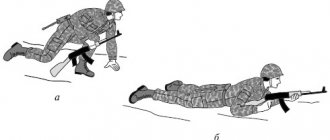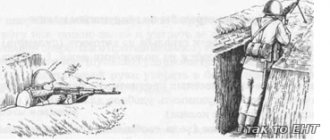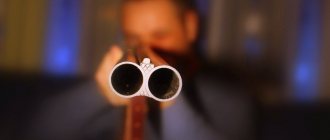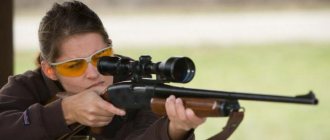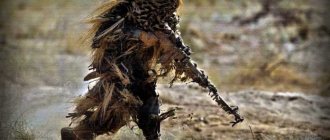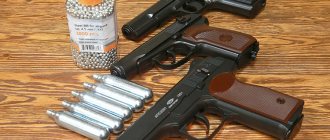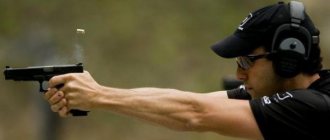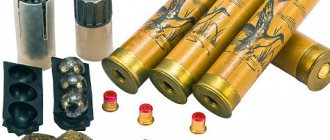Outline
- Time: 1 hour
- Place: class
- Method: oral presentation
- Guides and manuals:
- Manual “Safety measures for weapons in the service, classes in the PV.
- Security measures for weapons.
- Firing course KS, SO, BM and T SV-894
Study questions and timing:
- Introductory part - 5 minutes;
- Main part - 35 minutes;
- General safety provisions.
- Safety measures when handling weapons in service, exercises, classes, shooting and imitation means
- Final part - 5 minutes;
Progress of the lesson:
Introductory part:
- Accept a report on the students’ readiness for classes;
- Check the availability of training equipment, its appearance, the readiness of the trainees and, if necessary, order to eliminate the noted deficiencies;
- Announce the topic, goals, and educational issues of the lesson.
What the law says
Safety requirements when handling weapons (ammunition) are ensured by a set of practical measures recorded in legislative acts, charters and other similar departmental documents. Issues of circulation of weapons and their handling are regulated by special Federal Law No. 150-FZ of December 13, 1996. This law establishes that citizens of the Russian Federation can use the weapons they legally have to protect life, health and property in a state of necessary defense or emergency. Persons purchasing firearms for the first time are required to undergo training in order to learn the rules and acquire the skills to handle them safely. Requirements for the content of such training programs are established by Order of the Ministry of Education and Science of the Russian Federation dated November 30, 2016 No. 1489, in agreement with the federal executive body authorized in the field of arms trafficking (Rosgvardia).
GENERAL SAFETY POSITIONS WHEN HANDLING WEAPONS
PERSONNEL WHO HAVE NOT COMPREHENSIVE SAFETY MEASURES ARE NOT ALLOWED TO SHOOT AND SUPPORT SHOOTING!
Upon receiving the weapon, you must personally verify that it is on safety and not loaded.
In order to make sure that there are no cartridges in the chamber without removing the weapon from the safety, it is necessary to point the barrel to a safe place, disconnect the magazine (if it was attached), remove the weapon from the safety, pull the bolt handle (bolt) back, inspect the chamber, release the trigger and put the weapon on safety. Explore the shops.
It is prohibited to point a weapon at people, even if it is not loaded.
It is prohibited to take and fire from someone else's weapon or from a weapon whose handling you do not know, and to give your own without the permission (order) of the commander (chief of the guard).
When transferring a weapon on the orders of the commander (chief of guard) to another serviceman, be sure to check and warn that the weapon is unloaded (loaded) and the safety is on. Having received a weapon from another person, you must personally check whether the safety is on.
It is prohibited to leave weapons anywhere without the permission (order) of the commander.
Take special care when handling weapons while running, skiing, or traveling in a car, train, or airplane.
When boarding (disembarking) a car, train, or airplane, weapons are taken as convenient as possible, with the exception of company machine guns, which are handed over by the military personnel who boarded (previously disembarked) or those standing behind.
When running, you need to press the machine gun to your belt, and when traveling in a car, train, or plane, hold it between your knees with the barrel facing up.
If you discover a weapon malfunction, report to the commander.
How to hold a weapon
Weapon holding technique.
It is necessary to observe safety precautions when interacting with the pistol. Never point the gun at other people, animals, or yourself, as doing so can often cause dangerous injury, injury, or death. Even if the weapon is not loaded, caution must be exercised.
You need to hold the gun with one hand. Most often, the limb is completely straightened. However, the position in which the arm is bent is also considered correct. The wrist joint must be firmly fixed, since shooting accuracy depends on this. To do this, strain the muscles or use elastic bandages. The straightened arm continues the line of the shoulders or is located slightly to the left in order to aim without tilting the head.
SAFETY MEASURES WHEN HANDLING WEAPONS IN SERVICE
While on duty, weapons must be loaded and always ready for action. Keep the machine gun in the ready position for standing shooting at night, in the daytime - in the “on the belt” position or in the ready position for standing shooting; at the internal posts there are machine guns with a wooden butt - in the “belt” position, with a folding butt - “on the chest”. The lid of the bag with the loaded magazine must be fastened.
Having received the cartridges, check their quantity and make sure that there is no rust or bruises on the cartridges, whether the bullet is loose in the barrel of the cartridge, whether there is a green coating or punctures in the capsule, whether there are any training cartridges among the combat cartridges: if you find faulty cartridges, report to the commander (superior) .
Loading and unloading weapons must be carried out only in the designated place by order of the chief of the guard (military detachment), their assistants, and only according to the rules set out in the Charter of the Internal Troops.
Make sure that when performing combat duty, a loaded weapon is always on safety.
After discharging the weapon, put it on safety and report to the chief of the guard (military detachment).
It is forbidden to chamber a cartridge if there is no need to use the weapon: remember that the slightest carelessness in handling a weapon with a cartridge in the chamber can lead to serious consequences.
When firing a warning shot, point the weapon upward or to a safe place.
After using a weapon, if the need for further fire is not caused by the situation, immediately put the safety on, report to the chief of the guard (military detachment) or his assistant, and only under their direct supervision and at their command, discharge the weapon.
While on combat duty, never leave your weapon or transfer it to others.
IT IS STRICTLY PROHIBITED:
- Take an unsecured weapon (from another person).
- Point a weapon at people, towards residential premises and protected objects, regardless of whether it is loaded or not.
- Fire unless it is required by the need for service, and also fire in the direction of residential buildings, crowded places, flammable and explosive warehouses.
- To disassemble a weapon while on duty, without the need to remove it from the safety, chamber a cartridge and place your finger on the trigger.
- To serve with a cartridge in the chamber.
- Disconnect the magazine and remove cartridges from it during combat service.
- Load and unload weapons in unauthorized places and without the permission of a superior.
- Shoot from a signal pistol and a rocket cartridge at elevation angles of less than 40 - 45 degrees.
- Disassemble live and signal cartridges.
How to ensure safe handling of a pistol?
Safety
when shooting,
it is ensured
by a clear organization of shooting, strict adherence to the shooting course, established rules and
safety
, and high discipline of all military personnel. ... During shooting, all actions with weapons should be carried out only according to the commands of the shooting director.
Interesting materials:
What is the difference between Doppler and vascular ultrasound? What is the difference between a mercury thermometer and an electronic thermometer? What is the difference between Sukhozhar and Autoclave? Which reform of the 60s and 70s of the 19th century turned out to be the most consistent liberal? What kind of tires should you wear in winter? What fish is similar to pink salmon? What fish is similar to salmon? What is the tallest pyramid in the world? Which family is considered low-income in Kazakhstan? What series is the GeForce 9500 GT video card?
SAFETY MEASURES DURING EXERCISES, CLASSES AND SHOOTING
Perform any actions with weapons and ammunition only on the command of the commander (shooting director).
Before each loading, make sure that there are no foreign objects in the barrel (earth, sand, rags, etc.).
Load and unload weapons only at the command of the commander, while pointing the barrel of the weapon towards the target or in the direction indicated by the commander.
Before using training or blank cartridges, make sure that there are no live cartridges among them.
After training and shooting, immediately turn over to the commander all remaining, unused live, blank, small-caliber or training ammunition.
During shooting, do not show unnecessary haste and nervousness; remove the weapon from the safety only after taking the position for shooting and the commander’s command “fire”.
After finishing shooting, immediately put the weapon on safety.
REMEMBER!
The fire immediately stops independently or at the command of the shooting director in cases:
- the appearance of people, cars and animals on the target field, low-flying planes and helicopters over the shooting area;
- raising a white flag (lantern) at the command (precinct) post and shelters (dugouts);
- giving from the cordon post an established signal about the danger of continuing shooting;
- fire caused by shooting;
- loss of orientation by the shooter, especially at night.
IT IS STRICTLY PROHIBITED:
Load weapons with live and blank cartridges, as well as live and inert grenades until the “Fire” signal (command of the leader, commander).
Point the weapon at people, to the side and to the rear of the shooting range, regardless of whether it is loaded or not.
Open and fire from faulty weapons, faulty ammunition, in dangerous firing directions, with the white flag raised at the command (precinct) post and shelters (dugouts).
Leave a loaded weapon anywhere or transfer it to other persons, leave an individual weapon at a firing position (place for shooting) without the command of a leader (commander).
Preparing the shooter and pistol
Stance when shooting a pistol.
For training, choose clothes that will not restrict movement or interfere. Wear comfortable shoes with flat soles. It is prohibited to shoot from an unstable position. It is recommended to warm up before starting shooting. For better training results, you need to take the correct body position when shooting. There are different types of pistol shooting. There are 3 suitable positions:
- in line;
- in full turn;
- open.
They are chosen taking into account the type of shooting that a person does. In each pose, the head should not be tilted forward or tilted back.
Weapons also need to be prepared before practical training. The gun needs to be cleaned and lubricated regularly. For long-term exercises, the procedure is carried out between training sessions. Firearms are cleaned after each practical shooting session. If you do not use a gun, the number of cleanings can be reduced to 1 per week. Read more about the actions when shooting a pistol in our separate article.
After shooting, an RFS solution is required. This is a caustic substance with a shelf life of 24 hours. Unused remains must be disposed of. Use with caution to clean the inside of the barrel and elements exposed to powder gases. To clean the gun, you will also need tow and rags that have been removed from the fire. You also need to prepare gun lubricants. The weapon is inspected, after which it is disassembled and cleaned, lubricated and reassembled.
What you need to know about ammunition
Safety requirements when handling ammunition are also dictated by the need to prevent injury or death to people. Therefore it is prohibited:
- use cartridges not intended for firing from this type of weapon;
- force a cartridge into the chamber of the barrel or hammer it in;
- use faulty, expired, misfired cartridges, or ammunition filled with items not intended for use as submunitions;
- store ammunition in the same room with flammable, flammable and chemically aggressive materials.
Code of the shooter or citizen with a weapon
And a stick, it shoots once a year!
In the Yaroslavl shooting range of DOSAAF Russia, everything is formulated simply:
Shooter's Code or Prayer for shooting range visitors.
Shooter Code:
1. I will always treat the weapon as if it were loaded. 2. I will never point a gun where I don't want to shoot. 3. Before I shoot, I always check what is in front of and behind the target. 4. I will never touch the trigger with my finger until the barrel is pointed at the target.
Skills in safe handling of weapons at the level of reflexes, the ability to use these weapons professionally will be useful to a law enforcement officer, a military officer, a security guard, a collector, a hunter, an athlete shooter, or an ordinary citizen with a weapon defending his home from criminals, receiving participation in mass sports events with elements of shooting from weapons.
Of course, the first and foremost cornerstone of a firearms owner is safety. Getting acquainted with practical shooting, it is striking how cruelly, but at the same time logically and harmoniously the entire system of safe behavior of an athlete with a weapon is built in the ISPC. (International Confederation of Practical Shooting).
These rules are so reasonable, natural and easy to apply that with proper control of the judges and the participants themselves, any excesses are completely excluded, and this is when the participants in the competition are fully “armed”. Practical shooting has, figuratively speaking, precisely the applied “skeleton” of the entire system.
A person who has been trained at the DOSAAF shooting range in Yaroslavl, and has participated in at least several competitions in practical or bullet shooting, can be bold and call this citizen a bearer of advanced weapons culture.
By following the actions of instructors and teachers of the USTC DOSAAF of Russia in Yaroslavl during practical pistol shooting classes, students not only listen, but absorb their instructions.
The center's staff diligently and patiently help visitors to the shooting range, correct and give advice, and show sincere interest and participation in the education of citizens. They wholeheartedly want citizens to take as much of their knowledge as possible, to adopt as many skills as possible in the short time allotted for training. Such dedication of teachers and instructors bears fruit; right before our eyes, students begin to perform tasks on shooting accuracy and safety requirements with more and more confidence, their own successes and the successes of classmates give strength in mastering the science of “practical and bullet shooting.”
When studying safety requirements, teachers create an atmosphere of relaxed dialogue, the information is perceived easily and it seems that you yourself have found the right solution in a given situation. For clarity, the center’s employees act out scenes in person, simulating this or that case of violations. And all this is done easily and with humor. You can feel the enormous practical experience and deep knowledge.
And this is not only useful to know, but must be strictly observed and implemented.
Requirements and safety measures
Safety during classes to study the material parts of weapons, techniques and rules of shooting, and during shooting is ensured by the clear organization of classes and high discipline of students. Knowledge and strict compliance with the requirements and safety measures when handling weapons, as well as the order and rules established at the shooting range (shooting range), are also required. Before using a weapon, students must understand the safety precautions for handling it and the safety requirements when conducting shooting.
Safety measures when handling weapons. Safety measures when handling weapons are:
- Only persons who have studied the requirements and safety measures, the general structure of the weapon, the procedure and rules for its operation are allowed to handle weapons;
- Before starting any training with a weapon, check that it is not loaded;
- when inspecting a weapon, disassembling and reassembling it, equipping and unloading a magazine, exercise caution and follow the sequence of actions;
- It is strictly forbidden to aim, pull the trigger and point the weapon towards people and animals, even if the weapon is not loaded;
- if it is necessary to pull the trigger, you should give the weapon an elevation angle;
- It is strictly forbidden to use live ammunition for training purposes (not for shooting), before equipping the magazine with training cartridges, check whether there are any live ones among them;
- do not use misfired cartridges for training purposes;
- avoid hitting the cartridge primer;
- at the end of classes, put the weapon on safety;
- do not leave weapons and ammunition unattended, and at the end of classes, place them in the designated storage place.
Safety requirements for shooting. Shooting from a small-caliber or air rifle is carried out in a school shooting range, which ensures safe shooting. Shooting from a Kalashnikov assault rifle with live ammunition is carried out only at equipped shooting ranges of military units or DOSAAF shooting sports clubs.
Only persons who have the skills to handle weapons, know the procedure for behavior at the shooting range (shooting range) and the safety requirements when conducting shooting are allowed to shoot from any type of weapon.
During shooting with small-caliber and pneumatic weapons, the following rules must be observed at the shooting range:
- shooting is allowed only from weapons that are in good working order and have been used for normal combat;
- shooters enter the firing line only at the command of the shooting director;
- shooters are prohibited from aiming and pointing the weapon away from the target, to the rear, or pointing it at people or animals;
- at the firing line it is prohibited to take, load, touch a weapon or approach it without the command (permission) of the shooting director;
- weapons are loaded with combat (small-caliber) cartridges or bullets only at the command of the shooting director;
- it is prohibited to remove a loaded weapon from the firing line, as well as leave it anywhere or transfer it to other persons without the command of the shooting director;
- after the end of the shooting of each shift, the shooters collect the cartridges and, together with unspent cartridges, hand them over to the shooting director;
- after handing over the cartridges and cartridges, the shooting director inspects the weapon in accordance with the established rules;
- During shooting, unauthorized persons are prohibited from being on the firing line.
Shooting stops immediately when people and animals appear in the fire zone.
During shooting, a medical worker with medications and dressings must be present at the shooting range.
The shooter must know and strictly follow the established rules, all commands and safety requirements when shooting, and after shooting, hand over unspent cartridges (bullets) and casings to the supervisor.
Responsibility for order at the shooting range and safety rests with the shooting director, who is appointed by order of the educational institution.
The order of firing at the shooting ranges of military units is determined by the Firing Course.
Safety requirements when handling hand grenades. Grenades are carried in grenade bags. The fuses are placed in them separately from the grenades, and each fuse is wrapped in paper or rags.
Loading grenades (inserting the fuse) is permitted only before throwing them.
Before loading and placing in the bag, grenades and fuses must be inspected. The grenade body should not have significant dents or deeply penetrated rust. The igniter tube and igniter must be clean, free of dents and rust; the ends of the safety pin must be spread apart and not have cracks at the bends. Fuses with cracks and green deposits cannot be used.
When carrying a grenade, you must protect it from shocks, blows, fire, dirt and dampness. Soaked and contaminated grenades and fuses must be wiped and dried under the supervision of the commander; Do not dry them near the fire.
It is prohibited to disassemble live grenades and troubleshoot them, carry grenades outside of bags (hanging by the safety pin ring), and also touch unexploded grenades.
1. What safety measures must be taken when handling weapons? 2. Tell us about the safety requirements when conducting shooting. 3. What are the safety requirements?
INSTRUCTIONS airgun shooting exercises I. General provisions
1. Classes (shooting) in a shooting range (a place equipped for shooting) are carried out by order of the director of a school (gymnasium, lyceum, college, technical school, college) in accordance with the schedule of lessons (classes) and the club work plan. Pupils (students) are allowed to attend classes as part of a group or class led by a teacher who provides training in the basics of military service, or a coach.
2. Responsibility for organizing and conducting shooting lies with the teacher providing training in the basics of military service (coach), and during competitions - with the chief judge.
3. The teacher providing training in the basics of military service (trainer) bears full responsibility for the knowledge and compliance of all those involved in the shooting range with these rules.
4. Students who are free from shooting are in a specially designated place and follow the established order.
5. Shooters who carelessly handle weapons and ammunition or violate other safety rules are immediately removed from the shooting range.
II. Responsibilities of the shooting director (coach)
1. The leader of the classes must familiarize himself with these rules before starting shooting.
2. Check the serviceability of the pneumatic weapon, the condition of the shooting range (place equipped for shooting), compliance with the conditions for performing the exercises and fill out the shooting log.
3. Having finished the lesson at the time allotted by the schedule, put the shooting range in order, inspect the weapons, and collect the bullets.
III. Responsibilities of the shooters
1. Know and strictly follow all commands and safety measures when shooting.
2. After shooting, hand over the remaining bullets to the leader (coach).
The following is prohibited at the shooting range:
1. Conduct shooting without a teacher providing training in the basics of military service.
2. Fire from a faulty weapon.
3. Load weapons at the firing line without the command “Load!” or the “Fire!” signal.
4. Take a weapon without the permission of the shooting director.
5. Leave loaded and unloaded weapons with a closed barrel at the firing line.
6. While at the firing line, point the weapon to the rear, to the side, or aim at the targets if there are people in the direction of the targets.
7. Conduct training in the rear when shooting is carried out from the firing line.
8. Unauthorized persons, as well as students not engaged in shooting, should be at the firing line.
9. Turn fans on and off, as well as target line lighting lamps.
The person in charge of the shooting range, the teacher providing training in the basics of military service (coach, instructor) is obliged to:
1. Monitor compliance with these rules and compliance with safety measures during shooting and immediately take action in cases of violation.
2. Record all violations in the accounting book. Immediately report gross violations of safety measures or rules of behavior at the shooting range to the head of the educational institution or his deputy.
Shooting safety instructions
1. Always treat your air gun as if it is loaded and cocked. 2. Never point a gun at something you do not intend to shoot at. Never point a weapon at people!
3. The weapon should always be pointed with the barrel towards the targets, and when carried, with the barrel up.
4. Never keep your finger on the trigger, even if the weapon is unloaded and not cocked.
5. Loading and cocking weapons can only be done at the firing line at the command of the shooting director.
6. Consider the possible trajectory of a bullet when it penetrates the target, when it ricochets, and when it misses.
7. When shooting from a rifle with an optical sight installed, keep in mind that the axis of the barrel bore is below the axis of the sight. It is possible for a bullet to hit nearby objects that are not visible through the sight or located below the sight, but opposite the barrel.
8. When aiming through a telescopic sight, do not touch the eyepiece with your eyebrow. Air guns have recoil and can cause injury to the eyebrow or eye when fired.
9. Control the area where shooting is taking place. Especially when using an optical sight.
10. When shooting at short distances (less than 5 meters), wear safety glasses.
11. Do not pass loaded and (or) cocked weapons to each other.
12. Do not leave a loaded and/or cocked weapon.
13. Try not to leave weapons unattended.
14. Do not touch other people's weapons without the permission of the range director.
15. Do not touch the weapon if there are people in the target area, even if the weapon is not cocked or loaded.
16. When not shooting, keep the weapon open (with the bolt open), but not cocked or loaded.
17. Before shooting, check the technical condition of the weapon and the tightness of the mounting screws.
18. Do not disassemble a loaded and/or cocked weapon.
19. Repair, adjustment and testing of the functionality of the weapon is carried out in a specially designated place in compliance with all safety measures.
20. Unquestioningly follow the commands of the shooting director, otherwise you will be removed from shooting.
Positions when shooting from air guns (rifles)
When loading a spring-piston air rifle, it is best to hold the rifle by the barrel as you load the pellet into the bore. This will help save your fingers.
Always cock your air rifle gently, don't yank it, jerk it open, and then slam it to close it.
The index finger should be perpendicular to the trigger. In fact, only the middle finger wraps around and holds the handle of the gun. The thumb, ring and little fingers just rest on the handle.
Safety briefing
Don't take up arms without knowing this.
Painting in the safety instruction book
